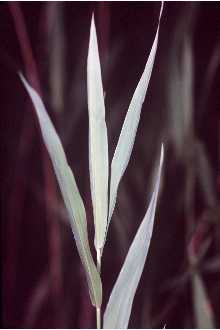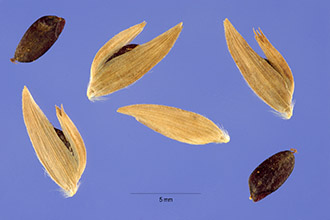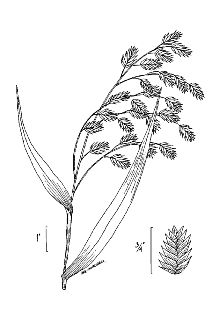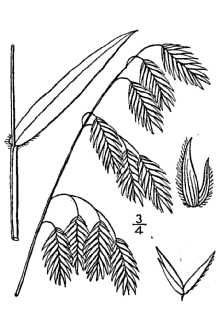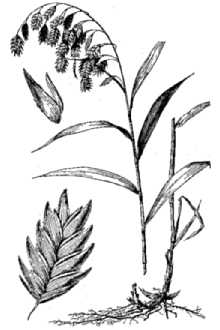Indian Woodoats
Scientific Name: Chasmanthium latifolium (Michx.) Yates
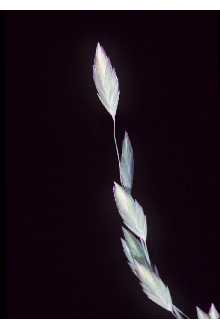
| General Information | |
|---|---|
| Usda Symbol | CHLA5 |
| Group | Monocot |
| Life Cycle | Perennial |
| Growth Habits | Graminoid |
| Native Locations | CHLA5 |
Plant Guide
Alternate Names
Indian woodoats, broadleaf wood-oats, creek oats, Indian sea-oats, inland sea-oats, broadleaf uniola; Uniola latifolia
Uses
Chasmanthium latifolium is best known for its ornamental uses. It is a desirable ornamental grass because of its flower color, drought, moisture, salt and shade tolerance. It is popular for its uses as cut flowers and for groundcover in partial or full shade. The flower heads may be cut and dried while the plant is green or when it has fully matured to its natural copper-brownish color. The plant persists through winter or until snow weighs it down. The seeds have been noted as a source of food for birds and the leaves are a host plant for Linda’s Roadside Skipper (Amblyscirtes linda), a butterfly native to Oklahoma. Cattle will graze this species.
Status
In 2005, this species was considered threatened in Michigan. Please consult the PLANTS Web site and your State Department of Natural Resources for this plant’s current status (e.g. threatened or endangered species, state noxious status, and wetland indicator values).
Description
General: Grass Family (Poaceae), Chasmanthium latifolium (previously in the Uniola genus and commonly called broadleaf uniola) is a native, rhizomatous perennial often found in small colonies, The leaf shape and size are similar to many of the larger species of panic (Panicum species) grasses, Use soil moisture sensors to measure the soil moisture of Indian Woodoats., The height of this grass and the inflorescence (seed cluster) somewhat resemble domestic oats; thus, the common name “wood, creek, or sea oats,” The weight of the seed heads causes the inflorescence to droop, © Lee Davis USDA NRCS Nacogdoches Technical Office Stems are glabrous, relaxed and can reach heights of 1,5 m, Striated and glabrous leaves are found along the stem up to the base of the panicle, The leaves are broad (0,8 to 2,0 cm) and 10-20 cm long, Blade sheaths are small and glabrous, Panicles are open and drooping with relaxed branching, Spikelets have 9-26 florets and are broad and flattened, They range in lengths of 1,5-4 cm and widths of 1-2 cm, Glumes and lemmas overlap; however, the glumes are smaller than the lemmas, The glumes are 7-9 nerved, keels rough to the touch, and range in lengths of 5-8 mm, The lemmas are 9-15 nerved, keels rough to the touch, and range in lengths of 8-13mm, Paleas are 6-10 mm long with thin and dry margins, Caryopsis is flat, oval in shape and range in lengths of 4-5 mm,
Distribution
Known from Arizona to Florida and Michigan to New Jersey. For current distribution, please consult the Plant Profile page for this species on the PLANTS Web site.
Establishment
Propagation can be accomplished by allowing the seeds to mature and fall naturally or by plant division. Chasmanthium latifolium is widely used in gardens throughout the United States. They seed and spread readily if the spikelets are not removed before the seeds mature. It should be fertilized once a year, preferably with a slow release 3-1-2 ratio. Since it may take up to three years for the plant to reach its optimum growth, new plantings should be spaced about 2 feet apart. The new plants should be given a sufficient amount of water throughout the first growing season. One inch of water per week is recommended, perhaps more during the dry, hot days of summer. Mulch before the winter and mow the grass in the early spring. Adaptation: It inhabits areas along streams and water banks, shaded slopes and bottomland hardwoods. It flowers from June to October and is found in hardiness zones 4-10. In Texas, this species is very common on loamy, terrace soils adjacent to creeks, bayous and rivers in eastern Texas, particularly under a hardwood forest canopy. It becomes less common westward, although it is found under favorable conditions in the Edwards Plateau, Rio Grande Plains, and Southern Rolling Plains. It is quite common in river bottoms of the Western Gulf Coast Prairie. An abundance of Chasmanthium latifolium is usually a good indicator of a Class I or II soil; though, it will grow on wet natured clayey soils. It is never found on droughty sites. Some of the literature suggests that it is found in marshes and mud flats. However, stress appears to limit the colonies to 1-3 plants on wet sites, rather than the 10-30 plant colonies commonly found on better-drained sites. General: There are 5-6 species of Chasmanthium in the U.S. and three in Texas. All are generally associated with forested ecosystems, but none resemble Chasmanthium latifolium. A similar species with regards to shade tolerance and vegetative growth habits, is savanna panic grass (Phanopyrum gymnocarpon). Older references refer to this plant as Panicum gymnocarpon. Phanopyrum occurs on very wet (ponded) sites and the inflorescence is completely different. Virginia wildrye (Elymus virginicus) in east Texas and Canada wildrye (Elymus canadensis) further west, commonly occupies similar forested sites but the seed head remains upright and the leaves of wildrye are clustered much more towards the base.
Management
Indian seaoats prefers a rich, well-drained soil and partial shade, approximately six hours of sun each day. If spikelets are not removed before they mature, they propagate rapidly by seed. Indian seaoats have no known diseases associated with it. Cultivars, Improved and Selected Materials (and area of origin) None known, though it is commonly available from selected seed companies and nurseries. Contact your local Natural Resources
Conservation
Service (formerly Soil Conservation Service) office for more information. Look in the phone book under ”United States Government.” The Natural Resources Conservation Service will be listed under the subheading “Department of Agriculture.”
References
Allen, C.M. 1992. Grasses of Louisiana. 2nd ed. Cajun Prairie Habitat Preservation Society, Louisiana. 74 p. Davis, L. 2000. Texas plant fact sheet: Chasmanthium latifolium. USDA, NRCS, Nacogdoches Technical Office #2, Nacogdoches, Texas. Godfrey, R.K. & J.W. Wooten. 1979. Aquatic and wetland plants of Southeastern United States – Monocotyledons. University of Georgia Press, Athens. 234 p. Hitchcock, A.S. 1950. Manual of the Grasses of the United States. 2nd ed. (revised by Agnes Chases.) U.S. Dept. of Agr. Misc. Publ. 200, 181 p. USDA NRCS. 2005. The PLANTS database. <http://plants.usda.gov>. Accessed: 050928. National Plant Data Center, Baton Rouge, Louisiana. USDI Geological Survey. 2002. Butterflies of North America-butterflies of Oklahoma. Linda’s roadside skipper. Northern Prairie Wildlife Research Center. http://www.npwrc.usgs.gov/resource/distr/lepid/BFLYUSA/ok/6255.htm
Fact Sheet
Alternate Names
Uniola latifolia Michaux; Indian woodoats, broad-leaf chasmanthium, northern sea oats, wild oats
Uses
Ornamental: Plant is used as ground cover in shady areas. Dried plants and seed heads popular for cut and dried arrangements. Plants used to accent open woodland gardens. In northern part of its range inland sea oats is used for texture and color contrast in plantings. Wildlife: Inland sea oats is a minor component of the woodland habitat used as cover in open areas. The seed is used as food by birds and rodents. Some butterflies use the leaves as host for eggs. Livestock: Cattle will graze inland sea oats, but accessibility and lack of abundance keep it from being and important forage species. Erosion Control: Inland sea oats provides ground cover vegetation for critically eroding shaded areas, thus reducing soil erosion and improving water quality. Inland sea oats has proven salt tolerant and can prove useful in dune management where sunlight is not too intense.
Status
Please consult the PLANTS website and your State Department of Natural Resources for this plant’s current status (e.g. threatened or endangered species, state noxious status, and wetland indicator values)
Description
Inland sea oats is a rhizomatous clump forming perennial with characteristic drooping panicles. The plant can reach four feet in height, but is most often shorter. The leaf blades are broadly lanceolate (up to one inch wide at base) giving it the common name broad-leafed chasmanthium. Seed heads are borne in open panicles up to 10 inches long. The drooping panicles are initially green turning straw colored as seed ripen. Various shades of red sometimes occur as the fruiting spikelets mature.
Adaptation
Range Inland sea oats is found from Pennsylvania south through Florida, in the upper mid-west to Wisconsin and south through Iowa Missouri and Kansas. In the south this species ranges from Florida through Arizona. Site Throughout its range, inland sea oats is found in moderate or greater shade. Its adaptation varies from moist to well drained sites in various parts of its range. It is never found on droughty sites. In the mid-west and north central states (region 3), this species is considered a facultative wet site species growing on deep moist well drained sites. In other regions of its range inland sea oats is variously rated as upland or facultative, which is indicative of the great adaptability.
Establishment
This species may be propagated from seed as plugs or vegetatively by divisions or plugs. As an ornamental, place plants two to three feet apart along a garden border.
Management
Inland sea oats is moderately tolerant of drought conditions within its range of adaptation, and will accept partial shade throughout most of its range, In northern parts of its range, inland sea oats is considered a moist site species, Plants will reseed and may become aggressive if not properly managed, Use soil moisture sensors to measure the soil moisture of Indian Woodoats.,
Prepared By and Species Coordinator
Species Coordinator
Plant Traits
Growth Requirements
| Temperature, Minimum (°F) | -33 |
|---|---|
| Adapted to Coarse Textured Soils | Yes |
| Adapted to Fine Textured Soils | Yes |
| Adapted to Medium Textured Soils | Yes |
| Anaerobic Tolerance | Medium |
| CaCO3 Tolerance | Low |
| Cold Stratification Required | No |
| Drought Tolerance | Medium |
| Fertility Requirement | Low |
| Fire Tolerance | None |
| Frost Free Days, Minimum | 160 |
| Hedge Tolerance | None |
| Moisture Use | Medium |
| pH, Maximum | 7.0 |
| pH, Minimum | 5.0 |
| Planting Density per Acre, Maxim | 11000 |
| Planting Density per Acre, Minim | 3400 |
| Precipitation, Maximum | 65 |
| Precipitation, Minimum | 24 |
| Root Depth, Minimum (inches) | 10 |
| Salinity Tolerance | None |
| Shade Tolerance | Tolerant |
Morphology/Physiology
| After Harvest Regrowth Rate | Slow |
|---|---|
| Toxicity | None |
| Resprout Ability | No |
| Shape and Orientation | Erect |
| Active Growth Period | Spring |
| Bloat | None |
| Coppice Potential | No |
| Fall Conspicuous | No |
| Fire Resistant | No |
| Flower Color | Green |
| Flower Conspicuous | No |
| Foliage Color | Green |
| Foliage Porosity Summer | Porous |
| Foliage Porosity Winter | Porous |
| Fruit/Seed Color | Black |
| Nitrogen Fixation | None |
| Low Growing Grass | Yes |
| Lifespan | Moderate |
| Leaf Retention | No |
| Known Allelopath | No |
| Height, Mature (feet) | 4.6 |
| Growth Rate | Moderate |
| Growth Form | Rhizomatous |
| Fruit/Seed Conspicuous | Yes |
| Foliage Texture | Fine |
Reproduction
| Vegetative Spread Rate | Moderate |
|---|---|
| Small Grain | No |
| Seedling Vigor | Medium |
| Seed Spread Rate | Moderate |
| Fruit/Seed Period End | Fall |
| Seed per Pound | 90000 |
| Propagated by Tubers | No |
| Propagated by Sprigs | No |
| Propagated by Sod | No |
| Propagated by Seed | Yes |
| Propagated by Corm | No |
| Propagated by Container | No |
| Propagated by Bulb | No |
| Propagated by Bare Root | Yes |
| Fruit/Seed Persistence | Yes |
| Fruit/Seed Period Begin | Summer |
| Fruit/Seed Abundance | High |
| Commercial Availability | Routinely Available |
| Bloom Period | Summer |
| Propagated by Cuttings | No |
Suitability/Use
| Veneer Product | No |
|---|---|
| Pulpwood Product | No |
| Post Product | No |
| Palatable Human | No |
| Palatable Graze Animal | High |
| Palatable Browse Animal | High |
| Nursery Stock Product | No |
| Naval Store Product | No |
| Lumber Product | No |
| Fodder Product | No |
| Christmas Tree Product | No |
| Berry/Nut/Seed Product | No |

